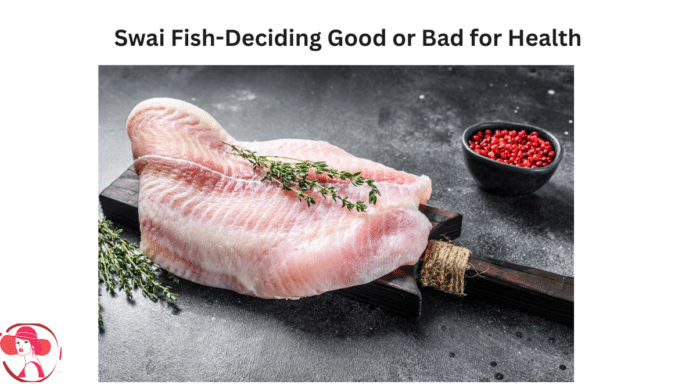Eating fish has its own set of benefits, but it comes with a hefty price tag. So, swai fish seems the best option for seafood lovers to reap the benefits of eating fish that are certainly easy on the pocket. However, due to rising concerns about its breeding and farming conditions, there’s confusion among people about whether it’s safe for health.
What Is Swai Fish?
You may not have heard of the swai fish, but you have probably eaten one. Swai is also known as basa and scientifically called “Pangasianodon”. They are intentionally misnamed to easily be sold off as high price fish. Swai fish originated in Vietnam in the Mekong Delta which makes Vietnam a leading fish farmer.
These fishes have white flesh in colour, a flaky texture, and a neutral flavour, which makes them absorb other flavours easily.
The US has prohibited calling swai fish Asian catfish to protect the sales of American catfish; however, these fish are closely related. Swai fish is enriched with proteins and nutrients, is easy on the pocket, and easily absorbs the flavours, making it popular. The knowledge that they are factory-farmed has altered everyone’s perception of their consumption.
This article will provide you with all the knowledge about swai fish, which will help you decide further about its impact on health.
Swai Fish’s Nutritional Chart
As we all know, including fish in our diet is important since it is rich in proteins and omega-3 fatty acids, which are essential for protecting against heart strokes and maintaining brain health. Swai fish, in a single serving (4 ounces or 114 grams), doesn’t have enough omega-3 fatty acids compared to the other fish, namely sardine and salmon.
| Name | Amount | Unit | % DV |
| Energy | 70.1 | kcal | |
| Protein | 15 | g | |
| Carbohydrates, by the difference | 0 | g | |
| Total lipid (fat) | 0.497 | g | 1% |
| Fiber, total dietary | 0 | g | |
| Sugars, total including NLEA | 0 | g | |
| Calcium, Ca | 0 | mg | |
| Iron, Fe | 0.362 | mg | 2% |
| Sodium, Na | 410 | mg | 17% |
| Vitamin C, total ascorbic acid | 0 | mg | |
| Vitamin A | 0 | IU | |
| Fatty acids, total saturated | 0 | g | |
| Fatty acids, total trans | 0 | g | |
| Cholesterol | 45.2 | mg | 15% |
Note:- % DV is meant as percentage of daily requirements
How Swai Is Breeded?
Swai fish is farmed in Vietnam in the Mekong freshwater river, but due to its high demand, they have been bred on a large scale in poor conditions, and use antibiotics to treat sick fish.
- Contaminated water
- The water in which swai are bred is highly polluted due to the improper disposal of the waste which includes disinfectant and chemicals used by farmers.
- Antibiotics use
- Swai fish is grown in a crowded pond where other fishes are grown too, therefore to minimize the risk of infectious disease farmers use antibiotics which is harmful to human health.
- Environmental hazard
- Whatever waste is generated in the breeding of swai fish, they are released into local water bodies which contaminate and pollute the environment.
- Lax regulations
- Due to the easy-going law practices followed in Vietnam, farmers are motivated to practice unsustainable and harmful methods of breeding.
- Mercury level
- It is also observed that there’s a high content of mercury found in swai from Vietnam which is unacceptable in comparison to other southeast Asian countries exporting the fish.
Is It Good or Bad?
After knowing so much about swai fish, it is safe to say that swai fish is not ideal for consumption which is irrelevant to its nutrient content but more towards its farming conditions. Here’s why you should avoid eating Swai fish:-
- High sodium level- swai from Vietnam contains sodium in unacceptable amounts as per observations which raises the cause of high blood pressure.
- Observation of mercury- as per some reports it is found that mercury was detected on the inspection of the imports of Swai fish.
- Poor farming practices- due to the absence of strict laws, there are unsustainable and poor farming conditions for the swai fish practiced in parts of Vietnam.
- Heavy use of antibiotics- swai fish growing in overcrowded contaminated water bodies results in infectious diseases which are prevented with the use of heavy antibiotics, resulting in the harmful toxins transmitted to humans.
Swai Fish’s Alternatives
Even if you haven’t ordered, you may have been served swai fish as fish in a restaurant or as a fish sandwich. They gained popularity because of their cheap prices, whether canned or fresh swai should be avoided.
Only those swai fish brands that fulfill US FDA norms should be bought and consumed, swai should not be eaten raw or undercooked, always cook it at the temperature of 145oF (62.8oC).
If you want to avoid eating Swai fish there are other options available which are American catfish which is caught from the wild, haddock, flounder or sole, pacific cod, and others to mimic the neutral or mild flavour, white-fleshed and flaky texture.
To get more omega-3 fatty acids, there are options such as sardines, wild-caught salmon, trout raised in freshwater, herring, anchovies, and pacific oysters, these contain less mercury content in them.
It’s recommended to eat different varieties of fish rather than having the same type of fish all the time. It will not only help in reducing the risks caused due to overexposure to potentially hazardous contaminants in the same type of fish.
To Sum Up All
Swai fish originated in Vietnam and resemble American catfish, which is prohibited to be called one. They became popular due to their pocket-friendly prices and neutral flavor, white-fleshed and flaky texture.
Mislabeled both intentionally and unintentionally, they are sold across the states in restaurants and as canned seafood. However, recently, there’s been a debate about whether the consumption of swai affects health in any way because of the poor and unsanitary conditions in which they are bred in Vietnam.
It’s advised to avoid swai because of its high mercury, and sodium content and use of pesticides and antibiotics used in their farming.
Recommended to switch to more nutrient-enriched alternatives like wild-caught salmon, American catfish, sardines, and much more.
FAQ’s
Q1. why is Swai so cheap?
Ans . swai fish are cheap because they are imported from Vietnam where they are grown on a large scale on a factory farming basis.
Q2. Is swai fish clean or unclean?
Ans. They are generally known to be unclean fishes due to the poor framing conditions in which they are grown with high sodium content in uncontaminated water, use of pesticides which makes them harmful for human health.
Q3. Is swai a good fish to eat?
Ans. Ideally, the swai fish is not considered healthy for humans to eat. Its nutrient content is less than that of other fish, it is low in carbohydrates, and it has fewer omega-3 fatty acids. So, compared to other fish, it has fewer nutrients. Moreover, the poor condition in which it is bred makes it more unhealthy to eat.
Q4. Is swai fish real?
Ans. Yes, it is a real fish that originated from Vietnam in the Mekong Delta region. It is closely related to American catfish and is also known as basa. Swai is a pocket-friendly fish with a mild flavour, white flesh, and a flaky texture. It gained its popularity for being cheap and its ability to absorb flavours.
Click here to know more















